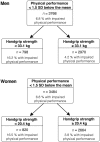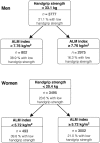Physical function-derived cut-points for the diagnosis of sarcopenia and dynapenia from the Canadian longitudinal study on aging
- PMID: 31307126
- PMCID: PMC6818452
- DOI: 10.1002/jcsm.12462
Physical function-derived cut-points for the diagnosis of sarcopenia and dynapenia from the Canadian longitudinal study on aging
Erratum in
-
Corrigendum.J Cachexia Sarcopenia Muscle. 2021 Dec;12(6):2262-2267. doi: 10.1002/jcsm.12811. Epub 2021 Oct 7. J Cachexia Sarcopenia Muscle. 2021. PMID: 34622575 Free PMC article. No abstract available.
Abstract
Background: Aging is associated with sarcopenia (low muscle mass) and dynapenia (low muscle strength) leading to disability and mortality. Widely used previous cut-points for sarcopenia were established from dated, small, or pooled cohorts. We aimed to identify cut-points of low strength as a determinant of impaired physical performance and cut-points of low appendicular lean mass (ALM) as a predictor of low strength in a single, large, and contemporary cohort of community-dwelling older adults and compare these criteria with others.
Methods: Cross-sectional analyses were conducted on baseline data from 4725 and 4363 community-dwelling men and women (65-86 years, 96.8% Caucasian) of the Canadian longitudinal study on aging comprehensive cohort. Physical performance was evaluated from gait speed, timed up-and-go, chair rise, and balance tests; a weighted-sum score was computed using factor analysis. Strength was measured by handgrip dynamometry; ALM, by dual-energy X-ray absorptiometry and ALM index (ALMI; kg/m2 ), was calculated. Classification and regression tree analyses determined optimal sex-specific cut-points of ALMI predicting low strength and of strength predicting impaired physical performance (score < 1.5 SD below the sex-specific mean).
Results: Modest associations were found between ALMI and strength and between strength and physical performance score in both sexes. ALMI was not an independent predictor of physical performance score. Cut-points of <33.1 and <20.4 kg were found to define dynapenia in men and in women, respectively, corresponding to 21.5% and 24.0% prevalence rates. Sarcopenia cut-points were <7.76 kg/m2 in men and <5.72 kg/m2 in women; prevalence rates of 21.7% and 13.7%. Overall, 8.3% of men and 5.5% of women had sarco-dynapenia. Sarcopenic were older and had lower fat mass and body mass index (BMI) than non-sarcopenic participants. While the agreement between current criteria and the updated European Working Group for Sarcopenia in Older Persons recommendations was fair, we found only slight agreement with the Foundation for the National Institute of Health sarcopenia project. Older persons identified with sarcopenia as per the Foundation for the National Institute of Health criteria (using ALM/BMI as the index) have higher BMI and fat mass compared with non-sarcopenic and have normal ALMI as per our criteria.
Conclusions: The proposed function-derived cut-points established from this single, large, and contemporary Canadian cohort should be used for the identification of sarcopenia and dynapenia in Caucasian older adults. We advise on using criteria based on ALMI in the diagnosis of sarcopenia. The modest agreement between sarcopenia and dynapenia denotes potential distinct health implications justifying to study both components separately.
Keywords: Aging; Dynapenia; Muscle mass; Physical performance; Sarcopenia; Strength.
© 2019 The Authors Journal of Cachexia, Sarcopenia and Muscle published by John Wiley & Sons Ltd on behalf of Society on Sarcopenia, Cachexia and Wasting Disorders.
Conflict of interest statement
A.‐J.T., S.S.W., E.R., J.A.M., and S.C. declare that they have no conflict of interest.
Figures



Similar articles
-
Utility of four sarcopenia criteria for the prediction of falls-related hospitalization in older Australian women.Osteoporos Int. 2019 Jan;30(1):167-176. doi: 10.1007/s00198-018-4755-7. Epub 2018 Nov 19. Osteoporos Int. 2019. PMID: 30456572
-
Prevalence of Sarcopenia and Relationships Between Muscle and Bone in Indian Men and Women.Calcif Tissue Int. 2021 Oct;109(4):423-433. doi: 10.1007/s00223-021-00860-1. Epub 2021 May 9. Calcif Tissue Int. 2021. PMID: 33966094
-
Prevalence of Sarcopenia Employing Population-Specific Cut-Points: Cross-Sectional Data from the Geelong Osteoporosis Study, Australia.J Clin Med. 2021 Jan 18;10(2):343. doi: 10.3390/jcm10020343. J Clin Med. 2021. PMID: 33477550 Free PMC article.
-
Assessment of Lean Mass and Physical Performance in Sarcopenia.J Clin Densitom. 2015 Oct-Dec;18(4):467-71. doi: 10.1016/j.jocd.2015.05.063. Epub 2015 Jun 10. J Clin Densitom. 2015. PMID: 26071168 Review.
-
The prevalence of sarcopenia in community-dwelling older adults, an exploration of differences between studies and within definitions: a systematic review and meta-analyses.Age Ageing. 2019 Jan 1;48(1):48-56. doi: 10.1093/ageing/afy106. Age Ageing. 2019. PMID: 30052707
Cited by
-
Age-appropriate BMI cut-points for cardiometabolic health risk: a cross-sectional analysis of the Canadian Longitudinal Study on Aging.Int J Obes (Lond). 2022 May;46(5):1027-1035. doi: 10.1038/s41366-022-01069-4. Epub 2022 Jan 29. Int J Obes (Lond). 2022. PMID: 35094005
-
A 16-week randomized controlled trial of a fish oil and whey protein-derived supplement to improve physical performance in older adults losing autonomy-A pilot study.PLoS One. 2021 Aug 23;16(8):e0256386. doi: 10.1371/journal.pone.0256386. eCollection 2021. PLoS One. 2021. PMID: 34424934 Free PMC article. Clinical Trial.
-
The association between dietary vitamins and the risk of sarcopenia in adults aged 20-59: a study based on the NHANES database.Front Nutr. 2025 Mar 26;12:1535190. doi: 10.3389/fnut.2025.1535190. eCollection 2025. Front Nutr. 2025. PMID: 40206945 Free PMC article.
-
Stool Microbiome Features and Weight Change Response to Treatment for cancer cachexia.J Cachexia Sarcopenia Muscle. 2025 Jun;16(3):e13816. doi: 10.1002/jcsm.13816. J Cachexia Sarcopenia Muscle. 2025. PMID: 40325598 Free PMC article.
-
Association of Bioelectrical Impedance Phase Angle with Physical Performance and Nutrient Intake of Older Adults.Nutrients. 2023 Mar 17;15(6):1458. doi: 10.3390/nu15061458. Nutrients. 2023. PMID: 36986185 Free PMC article.
References
-
- Goodpaster BH, Park SW, Harris TB, Kritchevsky SB, Nevitt M, Schwartz AV, et al. The loss of skeletal muscle strength, mass, and quality in older adults: the health, aging and body composition study. J Gerontol A Biol Sci Med Sci 2006;61:1059–1064. - PubMed
-
- Rosenberg IH. Sarcopenia: origins and clinical relevance. J Nutr 1997;127:990S–991S. - PubMed
-
- Clark BC, Manini TM. Sarcopenia =/= dynapenia. J Gerontol A Biol Sci Med Sci 2008;63:829–834. - PubMed
Publication types
MeSH terms
Grants and funding
LinkOut - more resources
Full Text Sources
Medical

